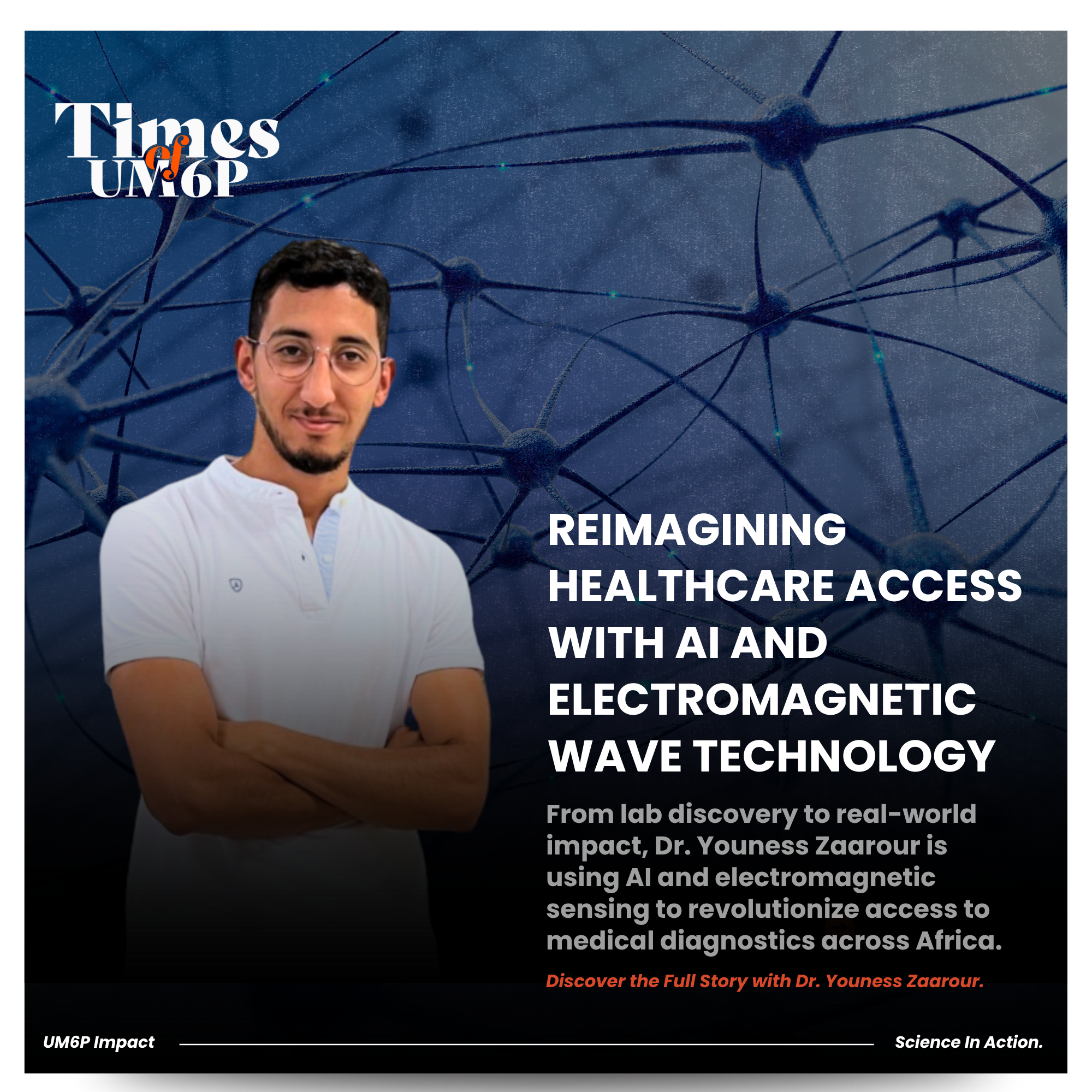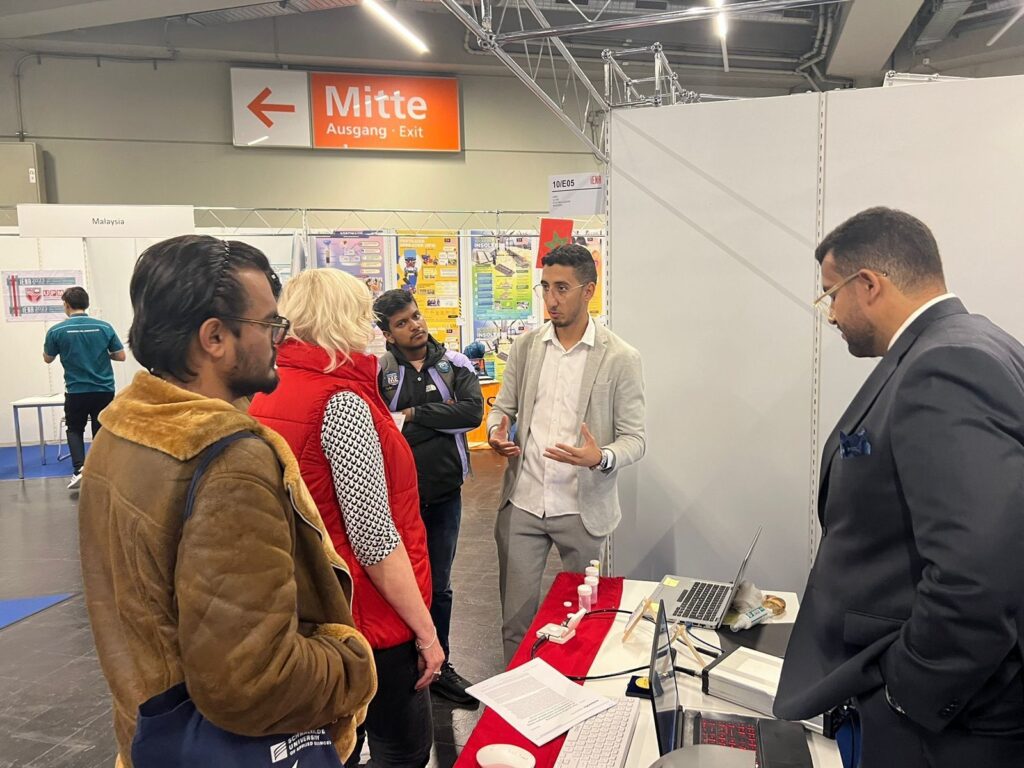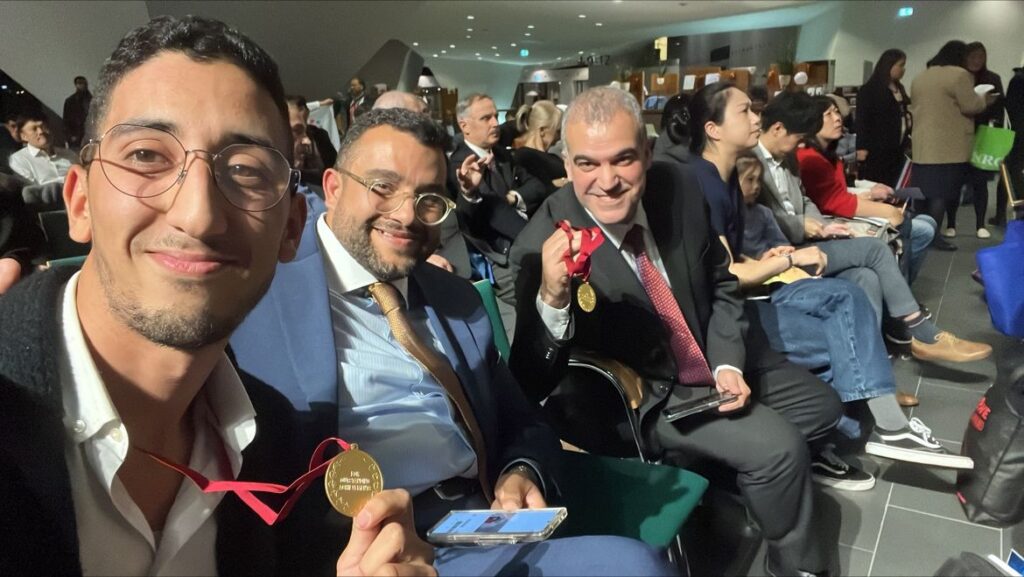How Youness Zaarour and UM6P Are Reinventing Glucose Monitoring Without Needles
UM6P Impact | Science in Action #10
Diabetes is a growing global health crisis. According to the International Diabetes Federation, over 537 million people currently live with the disease worldwide, a number projected to rise sharply to 783 million by 2045. Despite the rise of digital health tools, a staggering 93.7% of people with diabetes still rely on traditional, invasive finger-prick tests to monitor their glucose levels.
These daily routines are painful, repetitive, and carry a significant psychological and financial burden. Continuous Glucose Monitoring (CGM) devices—while promising—remain inaccessible to the majority of patients due to high costs, limited availability, and occasional technical inaccuracies.
In this context, the search for a non-invasive, reliable, and affordable alternative is not a technological luxury, but a humanitarian imperative.

At UM6P, a Different Vision of Biomedical Innovation
This global challenge has found a local response at the University Mohammed VI Polytechnic (UM6P), where researcher Youness Zaarour is leading a pioneering project in non-invasive glucose sensing. His team, operating from the Microwave Energy Sensing (MES) Unit within the DICE center, has developed a novel biosensor based on radiofrequency technology. The principle is both radical and elegant: rather than puncturing the skin to extract blood, the system uses electromagnetic waves to “read” physiological signals just beneath the skin’s surface. More specifically, it detects variations in glucose concentration by analyzing how microwave signals are reflected or absorbed depending on the dielectric properties of the tissue.
Through the combination of high-frequency antenna design, biological tissue modeling, and experimental validation, this project marks a turning point in how we imagine diabetes care in the Global South—accessible, painless, and data-driven.
Simulating Skin to Understand the Invisible
Testing such a sensor directly on human subjects is not the first step. To create a controlled and reproducible testing environment, Zaarour’s team constructed a sophisticated tissue-mimicking phantom—a synthetic model that accurately replicates the dielectric properties of human skin and veins. Composed primarily of gelatin, water, oil, soap, and salt, this semi-solid phantom includes embedded capillary-like channels modeled after real hand angiograms. These channels are used to inject glucose solutions of varying concentrations—from 60 to 200 mg/dL—corresponding to real clinical thresholds, from hypoglycemia to hyperglycemia.
What sets this phantom apart is its physiological realism. The vein-like channels are located exactly 1.5 mm beneath the surface, matching the penetration depth of the antenna. This alignment enables precise measurement without interference from deeper tissue layers like fat or muscle. The controlled setup also avoids repositioning the sensor, ensuring repeatable and accurate data collection.
A Coin-Sized Antenna That Reads What the Eye Can’t Se

At the heart of the system is a miniature patch antenna, specifically engineered to operate at 14 GHz. The device, no larger than a coin, is designed to sit on the skin and penetrate just enough to interact with the underlying capillary structures.
Its unique “Double-L” resonator design enhances electromagnetic field concentration, thereby improving the sensitivity of the system to small changes in glucose levels.
The operating principle is based on tracking the S11 parameter—how much of the microwave signal is reflected back. As the glucose concentration in the vein changes, the dielectric properties shift, altering the resonance frequency of the antenna.
During experiments, the antenna exhibited a frequency shift of nearly 80 MHz between low and high glucose concentrations, with a correlation coefficient R² = 0.988, confirming the robustness of the signal and the precision of the measurement.
From Simulation to Real-World Validation
The transition from theory to application required a meticulous experimental design. The team connected the antenna to a vector network analyzer and tested it on the skin phantom across five glucose levels. Each measurement was performed in a temperature-controlled lab, using high-precision instruments to capture the slightest resonance shifts. The results were compelling: the antenna not only detected the changes, but clearly differentiated between hypoglycemia (below 70 mg/dL), normoglycemia (around 100 mg/dL), and hyperglycemia (above 200 mg/dL).
The observed frequency drops matched the expected physiological behavior of glucose-induced dielectric changes.
Minor discrepancies between simulation and measurement were noted, largely due to a protective plastic layer used in real tests that wasn’t present in the simulation. Still, the system’s consistency and accuracy were strong enough to suggest that this device could realistically be adapted into a clinical or consumer application in the near future.
A Collective Effort, A Shared Vision
Behind this achievement stands a multinational and interdisciplinary team, reflecting UM6P’s philosophy of collaborative science. Youness Zaarour spearheaded the research, supported by Prof. Hafid Griguer’s supervision and strategic direction. The antenna’s design and simulation benefitted from the expertise of Tomas Fernandez and Juan Luis Cano at the Universidad de Cantabria in Spain.
Otman El Mrabet, from Abdelmalek Essaâdi University, played a key role in modeling the phantom’s anatomical features, while Fatimazahrae El Arroud and Rafiq El Alami oversaw the experimental setup and data acquisition.
Abdelouheb Benani, from the Institut Pasteur du Maroc, contributed to the preparation of biologically accurate glucose solutions, and Abdessamad Faik from LIMSET ensured material compatibility and stability. This synergy between Moroccan and European institutions proves that impactful science knows no borders—and that shared challenges call for shared solutions.

More Than a Sensor: A Step Towards Health Equity
This research is not only about measuring glucose—it’s about restoring dignity and accessibility to diabetic care. For millions of patients, especially in low- and middle-income countries, the promise of a bloodless, painless, low-cost monitoring system could transform daily life. It would reduce the psychological barrier to frequent testing, eliminate the ongoing cost of test strips, and make self-monitoring more consistent and effective.
More broadly, this project aligns with global efforts to democratize healthcare technology. It supports Sustainable Development Goals such as SDG 3 (Good Health and Well-being), SDG 9 (Industry, Innovation and Infrastructure), and SDG 10 (Reduced Inequalities). It also represents a model of African-led innovation, capable of addressing global challenges through local intelligence and engineering.

Looking Forward: From Lab to Life
With validation complete, the team is already planning the next steps. To enhance realism, the phantom will be expanded to include fat and muscle layers, mimicking more accurately the complex structure of human tissue. This evolution will allow for more representative testing conditions and prepare the system for future in vivo applications.
In parallel, additional variables such as temperature variation, pH levels, and biological interference will be incorporated to refine performance and improve measurement stability under real-world conditions. These adaptations are crucial for ensuring the device remains accurate across diverse environments and patient profiles.
Meanwhile, the antenna itself will be miniaturized into a wearable patch, potentially integrated with Bluetooth connectivity for real-time glucose tracking via smartphones or clinical dashboards. The ultimate objective is a non-invasive, low-cost, and portable glucose monitor, deployable in any setting—from urban hospitals to rural clinics. With every successful iteration, this vision edges closer to reality.
The Researcher Behind the Vision
Dr. Youness Zaarour is not only a specialist in microwave physics and dielectric materials—he is a system thinker working at the intersection of science, technology, and society.
From oil sensing to biomedical applications, his work is rooted in a belief that scientific knowledge must be converted into tools that serve real people, especially in contexts where conventional solutions are out of reach. At UM6P, he embodies the spirit of Science in Action—science that listens, adapts, and empowers.
A New Frontier for Responsible Innovation
If this project marks a scientific breakthrough, it also invites reflection on how innovation is designed, deployed, and distributed. In many ways, what Youness Zaarour’s work proposes is a subtle shift in biomedical philosophy—from centralized, high-cost solutions dependent on specialized infrastructure, to decentralized, adaptive technologies that respond to diverse environments and users. By designing a device that is not only non-invasive but also easy to replicate and calibrate, the project offers a blueprint for technologies that are not just “smart” but socially intelligent.
It also raises questions of ownership and openness. The system is built on open-source logic, with replicable methods, locally available materials, and transparent calibration protocols. This means that academic institutions, hospitals, or even startups across Africa, Asia or Latin America could build upon this work and tailor it to their own populations. In this sense, the project transcends the lab—it is a contribution to a broader movement for technological sovereignty in health.
The Future of Health, Engineered in Morocco
There’s something profoundly symbolic about this innovation emerging from Morocco, and more precisely, from UM6P. In a world where most biomedical devices are imported, patented, and priced out of reach, this project represents a reversal of the usual technological flow. It shows that Africa can produce, not just consume; that Moroccan labs can create medical breakthroughs, not just pilot imported ones; and that the Global South can lead the conversation on accessible, ethical, and human-centered healthcare innovation.
This work positions UM6P not just as a research institution, but as a catalyst for applied science with global impact—a place where micro-antennas become macro-messages about dignity, precision, and justice.
The Power of Story: Why This Article Exists
Science needs more than lab reports to live. It needs stories. This article is part of Science in Action, a series by Times of UM6P that seeks to translate complex research into meaningful narratives—not by simplifying, but by clarifying; not by reducing, but by recontextualizing. Here, we believe that science is not just a body of knowledge, but a social force. And when researchers like Youness Zaarour invent tools that reduce pain, increase autonomy, and shift paradigms, they deserve a platform that reflects their ambition.
What began as an antenna became an argument—for equity, for dignity, and for the power of the invisible to transform the visible. From phantom veins to global visions, this story reminds us that the smallest waves can sometimes carry the loudest signals.
A Healthier Tomorrow
🩺 Diagnostics with Dignity
What if diabetic patients no longer needed to prick their fingers to know their glucose levels? Thanks to Youness Zaarour’s microwave sensor, this scenario is no longer speculative—it’s within technological reach. By eliminating the need for blood sampling, his work opens the door to painless, continuous, and dignified glucose monitoring, especially for populations where affordability and access are critical barriers to care.
📡 Non-Invasive, Data-Driven Health
This system does more than measure—it empowers. With real-time feedback and a sensor that reads physiological variations through the skin, patients could monitor their glucose levels wirelessly, discretely, and safely. In contexts where conventional devices are prohibitively expensive or invasive, this shift could redefine health access. The platform also promotes data democratization, where patients—not just institutions—own and control their health insights.
🌍 Aligned with Global Goals
Zaarour’s innovation contributes to several Sustainable Development Goals: SDG 3 – Good Health and Well-being, SDG 9 – Industry, Innovation and Infrastructure, and SDG 10 – Reduced Inequalities. By offering a scalable, affordable, and non-invasive alternative to conventional glucose monitoring, this project positions Morocco—and Africa—as a leader in accessible biomedical innovation.
A Call for Collaboration: Shaping the Future of Non-Invasive Monitoring
🛠 Let’s Build It Together
Medical sensing should be co-designed with patients, not just for them. Zaarour and his team advocate for collaborative design, from tissue phantom development to future app interfaces. The objective goes beyond technical accuracy—it also aims for usability, equity, and inclusion. The vision is clear: create diagnostics that reflect real-life needs, not just lab specifications.
👨🔬 Meet the Scientist: Youness Zaarour
Youness Zaarour is a biomedical researcher at the Microwave Energy Sensing (MES)-DICE unit at UM6P. His expertise spans microwave physics, signal processing, and bio-electromagnetism. From oil diagnostics to phosphate sensing and now glucose monitoring, his mission is consistent: science that matters, tools that serve, and systems that scale.
📄 Read the Full Scientific Article
Microwave Antenna Sensing for Glucose Monitoring in a Vein Model Mimicking Human Physiology –

Leave a Reply